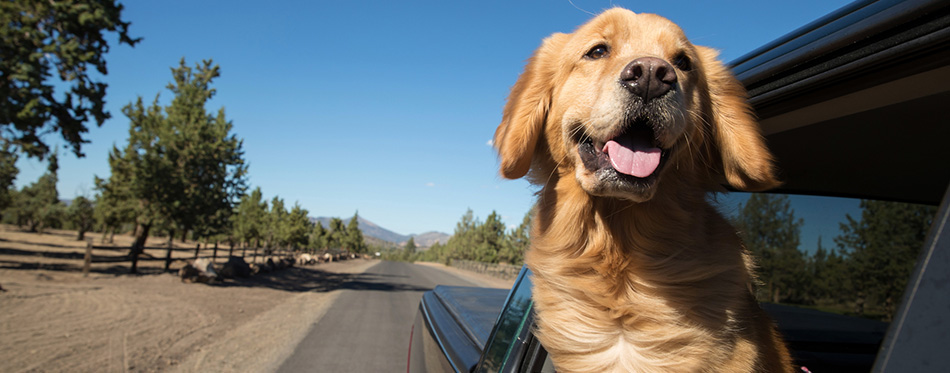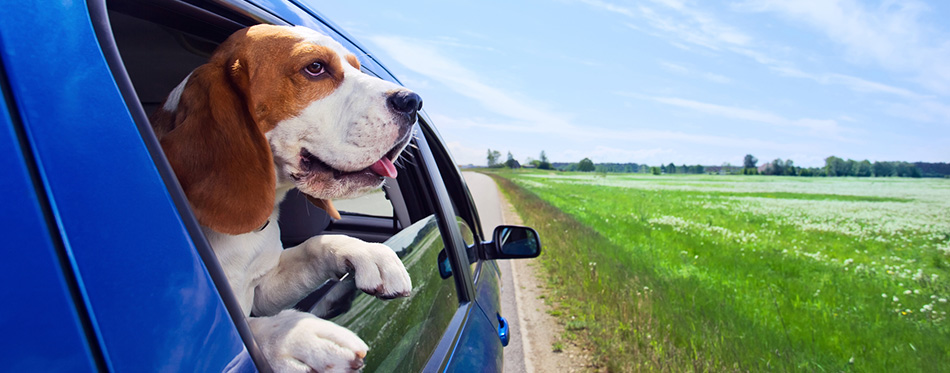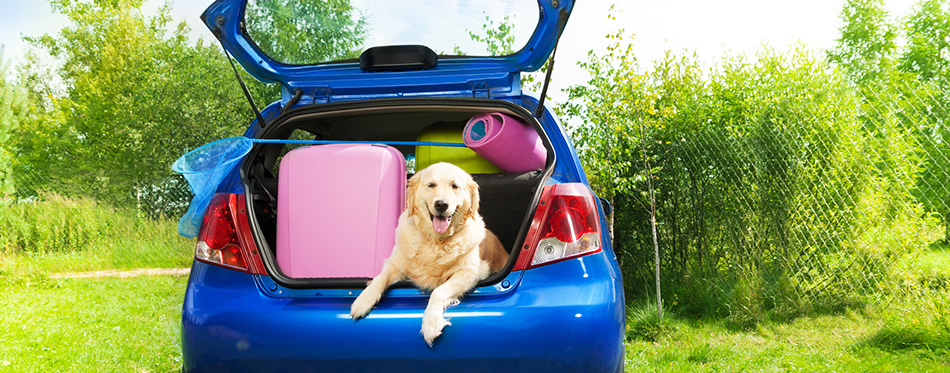The great American road trip is a big part of the US lifestyle but what happens when you get a four-legged friend? Is this a part of your life that you must give up forever? The answer is a definite ‘No’ because there is no reason why you cannot take your dog with you.
With some careful planning and preparation, your pooch can enjoy the trip just as much as you do. Here’s an essential guide to a successful road trip with your dog.

Planning the Trip – What You Need to Buy
The more planning you do, the more successful your trip will be. If your dog is relaxed and happy, you will be too. The key to a smooth road trip with a dog is the correct equipment.
Start by deciding how you will restrain your dog in the car. The word ‘restrain’ may seem a bit extreme but it simply is not safe for your dog to wander around the car whilst you are traveling on the highway. Sadly, collisions can and do occur and even though you are a very careful driver, there are others who are not.
An unrestrained dog is a danger to themselves and to others in the car should a collision take place because they will be flung around inside the vehicle. Also, an unrestrained dog can get very excited and rush around from one seat to another. This is distracting for the driver and could even get in the way of the driver reaching the controls. Some States require dogs to be suitably restrained within the vehicle so you may even be breaking the law. Finally, having an unrestrained dog in the car may breach the terms of your insurance policy and you may find that you cannot make a claim if you have an accident.
You have two options for restraining your dog in a vehicle which are a dog crate or a dog harness with a dog seatbelt. You may also like our articles on dog car seats and dog car barriers.
- Dog crates for car travel
This is by far the safest method for you and your dog. Crates come in all shapes and sizes so you will be able to find one that fits in the trunk of your car. However, crates can also be thrown around the inside of the car in an accident and present a hazard to the occupants of the vehicle so they must be tied down. There may be specific anchor points and ties so that you can secure the crate into place. Alternatively, you can use your own ropes or bungee cords to keep the crate in position should you be involved in an accident.
A crate is a considerable financial investment but you can also use it inside your home or when you are visiting other houses.
Take a look at our reviews of Dog Crate Pads and Dog Crate Covers for more options.
- Dog harness and seat belt
If space is very limited in your vehicle, an alternative to the crate is a harness that fits around the dog’s body and fixes onto the car’s seatbelt. In the event of a collision, your dog will be restrained. This is not as safe as a crate but is better than nothing.
You should not put your dog in the front passenger’s seat of your car, they should always be secured in the back seat. The airbags in the front seat are designed for a human and not for a dog and could cause serious injuries. Head over to our review of the best dog car harnesses for more options.
Obviously, you will do all you can to make sure that your dog does not go missing during your road trip but it is a possibility. It is most likely to happen during rest stops, particularly if your dog becomes frightened in unfamiliar surroundings and runs off. It is vital that they have a collar with your contact information or have a microchip. Don’t forget to make sure that this information is up to date before you set off.
- Food and drink
Even short road trips will require water stops and longer trips will require breaks for your pooch to eat, drink and have a pee or a poop.
It’s a good idea to invest in some collapsible food and drink bowls and some are small enough to fit in your pocket. Take adequate quantities of your dog’s usual food and dog treats and try to keep to their feeding routine as much as you can. This is not the time to experiment with a different type of food because a dog with a stomach upset is no fun on a long road trip! It may be a good idea to take some bottled water just in case you can’t find a fresh supply of drinking water on your journey. Find out more about dog water bottles here.
- Emergency travel kit
Traveling with a dog is a bit like traveling with kids, you need to prepare for any eventuality! However, you have to balance this with how much room you have! Here are some things that could be useful:
- Injury treatments. First aid materials such as bandages or liquid bandage, animal pain reliever and wound cleaner. For more options, check out our detailed review of the best dog first aid kits.
- Anti-nausea medicine. You can get this from your vet if it is required by your dog.
- A current photo of your pet. In case your dog goes missing at a rest stop.
- Poop bags. Essential for rest stops – make sure you have plenty of them.
- Extra dog toys. To keep your pooch amused in the crate and on rest stops.
- Cleaning wipes and paper towels. Very important for clearing up accidents and after feeding. For more options, check out our detailed review of dog wipes.
- Extra collar and dog leash. Just in case the original leash and collar get damaged.
- Very useful for constraining your dog if necessary.

Preparing Your Dog for the Trip
The dogs that most enjoy road trips are the ones that are accustomed to traveling in cars and that are confident and happy in a vehicle. Remember that when your dog is enjoying your road trip, you are more likely to have a good time too so make this your aim!
Overcoming Car Fear and Phobia
You need to start preparations when your pup is small. Make car journeys a part of their socialization training. Start off by simply taking them inside a parked car. Then, introduce the crate or the harness and allow them to become accustomed to that. Of course, you can continue crate training inside your house too. Now, you can start the engine to allow your pooch to become familiar with the sound and the vibrations of the engine but don’t actually drive off anywhere.
Once your pup is comfortable with the crate or the harness you can make frequent, short journeys but always have one adult to drive and another to keep an eye on your pup. Gradually build up the length of the journeys.
It is important that your pup learns to associate your car with a fun experience so take them somewhere that they like. This could be the park or the beach. If you only ever take them in the car to the vet, this can lead to a type of car phobia especially if they don’t like the vet!
You can prevent car phobia from developing by giving them a nice treat like a game or a walk at the end of every car journey. You want your pooch to think that cars are fun!
Car Sickness in Dogs
Some dogs do suffer from car sickness and this makes the journey very unpleasant for them and you! It can affect all breeds but is more common in younger dogs so your pup may grow out of it. It is thought that the ear structures used for balance are not fully developed in pups and this makes them feel sick in a car.
This is a problem because a pup that has been sick in your car will now associate car journeys with feeling ill even after their delicate ear structures have fully developed. Therefore, it is important that you take steps to make your pup feel better.
Some motion sickness is caused by stress so use the above methods to acclimatize your pup to car travel gradually and to make it a positive experience. Feeding your pup just before a car journey is also a bad idea. Give them an hour or so to digest their meal. Traveling on an empty stomach is not advisable either. Make sure that the car is not too hot and that it is well-ventilated.
However, if your dog is still suffering, you should speak to your vet about getting some medication for car journeys before car phobia sets in. Remember that car sickness does not always result in actual vomiting so watch out for other signs that your pup is feeling poorly. Some signs of car sickness in dogs include listlessness, yawning, panting and excessive drooling.

On the Car Journey
On the day you set off, gather together everything that you will need for your journey. Give your pooch a light meal and allow at least an hour or so for them to digest it. Preferably, take your dog for a walk so that they have had some exercise.
Now you can settle them into their crate with some reassuring words and a favorite toy or blanket. Double check that the crate is secured. Make sure that there is plenty of ventilation and that the car is not too hot. Remember that your pooch is wearing a fur coat so they may need it a little cooler than the human occupants of the car. If necessary, pop the AC on to keep your dog comfortable. Also, be aware that direct sunlight can create hotspots within the car so some shading may be needed.
The key to a successful road trip with a dog is taking plenty of breaks. Plan your journey in advance and choose locations where it will be suitable to exercise your dog. Take them for a walk around and have a poop or a pee if they need to. Offer them some fresh water. On long journeys, you may need to feed them but remember to allow them time to digest the food before you set off again. Some service stations have designated dog walking areas but parks or dog-friendly attractions are just as good.
Never leave your dog unattended in your car. Dogs cannot sweat and therefore cannot cool themselves down so it is possible for them to overheat very quickly. It is not sufficient to wind down a window, this will not cool them down. Also, remember that your dog is in unfamiliar surroundings and is likely to become very distressed when you walk away from them.
Some dogs can get overstimulated during car journeys and this is probably caused by a combination of the movement of your car and the sight of other cars and objects moving quickly across the window as your car speeds along the highway. An over-stimulated dog will bark a lot and if your dog has started to do this on car journeys, a crate can help to solve the problem. Also, give them a puzzle toy stuffed with their favorite treat to keep them busy and stop them looking out of the window. If you are looking for more options, check out our guides on interactive dog toys and toys for blind dogs.
Car Travel With Dogs: Dream vs Reality
It may look cool to be hurtling down the freeway with your four-legged friend next to you in the passenger’s seat with their head sticking out of the window but this is for movies and not real life! It presents all sorts of dangers for both of you and could result in a very nasty accident. Responsible dog owners do not let their dogs stick their heads out the window unless the car is stationary.
The reality is that a road trip with dogs can be a lot of fun but only if you prepare and plan carefully to keep your dog safe and happy. Have a great trip!

